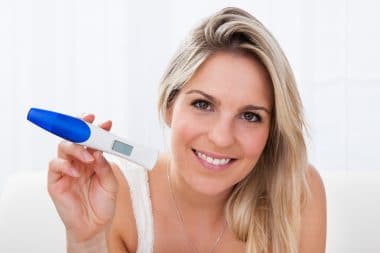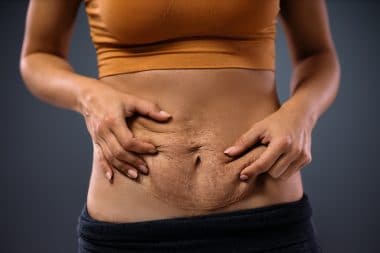Since stretch marks are common among many people there are a number of treatment modalities to be applied. The most important factor is the selection of the suitable method on the basis of the severity of the condition. Even though it is not a life threatening condition, many people need treatment because of social stigma. In majority of cases stretch marks remain for a long time. There are some natural and modern methods to deal with stretch marks. The effect of treatment depends upon age, skin tone, general health, nutritional status and most importantly, the stage of stretch marks. When the treatment is given initially the result will be better; if delayed, then the result may not be as good.
1. External applications:skin hydrators
Topical creams and moisturizers, skin firming agents and skin hydrators are available in different trade names but they give fewer results in long standing cases; however the following topical agents are widely used with varying results.
Topical agents are supposed to promote collagen synthesis when applied on the affected skin.
- Topical retinoid therapy (retin A treatment) Examples: – Retinaldehyde, tretinoin, Isotretinoin, adapalene etc are used. Tretinoin should not be used during pregnancy and lactation.
- Glycolic acid creams are used to remove the outer layers of the skin.
- Silicon dioxide is used with some benefits.
- Elastin cream can promote formation of elastin.
- Hydroxyproline containing creams are useful.
- Alpha hydroxyl acids (8 to 10%) are used with good results.
- Glycerol is used as a moisturizer.
- Topical vitamins (E, A & K).
- Vitamin E oil is commonly used.
- Creams containing marine tissue extract are useful externally.
- Antioxidants (they act as scavengers of free radicals).
- Vaseline is routinely applied on the skin.
- Biopeptide CL containing creams are useful.
- Topical sunless tanning products are also useful.
Some naturally available substances are also used with good results, which are mentioned under a separate heading.
2. Masking methods:
Here the stretch marks are not removed, but kept covered by appropriate dressing and other methods like tattoo or ornaments etc.
3. Dermabrasion:
Here the superficial layer of the skin is removed by a procedure called micro dermabrasion, which will increase collagen production resulting in the formation of normal healthy skin. This method is recommended for those who do not prefer painful and expensive surgical techniques. This is the cheapest and harmless method among all types of skin resurfacing techniques. Here no chemicals or medicines are required. Micro dermabrasion involves the use of a pen like instrument that sandblasts the skin with tiny crystals to remove the cells in the superficial layer of the skin. On an average 10 to 12 sittings are needed for a better result.
4. Skin remodeling:
Here needles or lasers are used. Needle pricks can induce collagen production in the affected area.
5. Chemical peeling:
Here some chemicals in cream base are applied on the affected area. These creams can remove the epidermis of the skin. The dermis can produce more collagen and gradually normal skin is formed.
However this method is painful and may even cause skin injury due to some reactions. Glycolic acid and Jessner’s peels are commonly used. For medium depth peeling Trichloracetic acid is used. Here the skin becomes red & swollen for a few days and gradually becomes normal.
6. Laser treatment:
This is the most commonly used method, which gives better result than any other method. Statistics show that about 70% of cases treated with laser have given good results. However, laser can’t give good results in all cases as it works on certain skin types.
Different types of lasers are used on the basis of the color of skin. Here a narrow beam of laser is transmitted through the affected skin that can stimulate the production of collagen. Laser can stimulate the division of fibroblasts of the skin, thereby promotes tissue repair. It is true that laser can’t remove stretch marks, but improves their appearance. Dual laser treatment is effective after a few sittings. Pulse dye laser therapy is also used with sizeable results and is a better choice among different laser treatments. However laser therapy is expensive and also causes pain during the procedure. More over five to six sittings are needed to make some noticeable improvement. Laser therapy gives better results in red raised scars and pinkish stretch marks. However, modern laser therapy is very expensive.
7. Cosmetic Surgery:
Here surgical methods like skin grafting, skin reduction, liposuction etc are done. In case of horrible abdominal stretch marks with folded skin due to fat deposition that does not respond to normal methods can be managed by abdominoplasty. However this method is very expensive and may cause scars on the operated site.
8. Endermologie:
This mode of treatment was invented in France. Here, a special machine is used to massage the affected site with the help of rollers and a suctioning action of the machine. This method is supposed to improve the blood circulation and removal of toxic substances from the skin. It can also strengthen the connective tissues of the skin. Series of endermologie procedures have given marked improvement in the appearance of stretch marks.
9. Anti depressive medicines:
Those who are over anxious about stretch marks need mild doses of antidepressants and psychotherapy.
NATURAL SUBSTANCES FOR STRETCH MARKS
Many of us spend a lot for the prevention and treatment of stretch marks. Almost all modern methods are very expensive. A large number of external applications and cosmetics are also costly. But the same benefits can be achieved by using some natural substances available in the market. These may be natural food articles or natural substances for external application. Some household articles are very helpful and cheaper.
- Cocoa butter is the most popular external remedy for stretch marks.
- Oils: Examples: Fish oil, virgin olive oil, jojoba oil, lavender oil, borage oil, almond oil, apricot kernel oil, emu oil, sesame oil, wheat germ oil, rosehip oil, coconut oil, sandal wood oil, carrier oil, sunflower oil etc help to promote collagen production.
- Chamomile can be applied externally.
- Mimosa tenuiflora bark extract is indicated externally.
- Shea butter minimizes appearance of stretch marks.
- Avocado juice and salads are nutritious etc.
- Indian pennywort is used externally.
- Aloe Vera extract or gel is indicated externally.
- Grated beeswax can be applied externally.
- Emblica is used as a source of vitamins.
- Siegesbeckia orientalis is used externally.
- Mango butter is used externally.
- Persea gratissima extract is used externally.
- Equisetum arvense extract is used externally.
- Hedera helix extract is helpful for external use.
- Grape seed extract is applied externally due to its anti oxidant properties.
- External application of hibiscus makes the skin moist and prevents collagen rupture.
- Ivy wood extract is used externally due to its anti inflammatory properties.
- Centella increases blood circulation and promotes collagen synthesis.
- Ginseng is used both externally and internally due to its collagen breaking properties and nutritive value.
It is a fact that most of the moisturizers work for few hours and hence give temporary benefits. However, the process of massaging itself is helpful as it increases the blood circulation, that’s why all external applications are useful to certain extent irrespective of their therapeutic quality.





